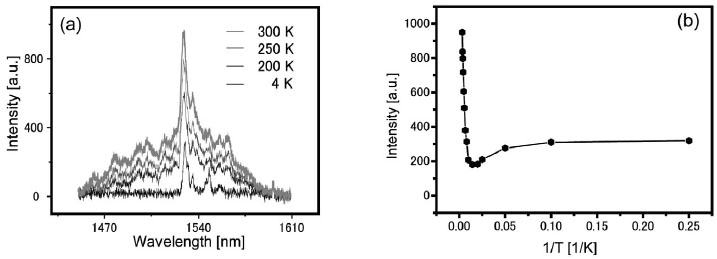Telecommunicatios Wavelength in Silicon Photonics
Materials Science Laboratory, *Optical Science Laboratory
Erbium silicates and erbium oxide, such as Er2SiO5 and Er2Si2O7, are promising materials as light emitters at the telecommunications wavelength
and as optical amplifiers in the field of silicon photonics. In the erbium
compounds, the density of erbium ions is 1022 atoms/cm3, which is orders of magnitude greater than that typically obtained by
Er ion implantation in silicon substrate, allowing access to a large number
of emitting centers. In this work, we combined real-time synchrotron radiation
grazing incidence X-ray diffraction (GIXD) and PL experiments to optimize
the structures and optical properties of erbium silicates on silicon substrate.
We firstly studied the formation of the erbium silicates during annealing
in Ar gas and O2/Ar mixture gases in real time. We determined the crystallographic structures
and the temperature of crystallization, and assessed the possible reactions
for the silicate formation. We secondly measured the photoluminescence
(PL) from a sample annealed at 1060ºC [1].
The 100-nm-thick erbium oxides were deposited on 100-nm-thick silicon oxide film grown on Si(001) substrates by reactive sputtering at room temperature. The samples are then annealed at up to 1300ºC in Ar and O2/Ar mixture gases. In micro-PL experiments, the samples were pumped by CW laser at the wavelength of 532 nm.
The GIXD measurements show that erbium silicates and erbium oxide are
formed by interface reactions between silicon oxide and erbium oxides deposited
on silicon oxide by reactive sputtering in Ar gas and O2/Ar mixture gas ambiences. The erbium silicates are formed above 1060ºC in Ar gas ambience and above 1010ºC in O2/Ar gas ambience, and erbium silicides are dominantly formed above 1250ºC.
The I15/2-I13/2 Er3+ PL from the erbium silicate exhibits abnormal temperature dependence (see
Fig. 1). The PL intensity from the Er2SiO5 silicate exhibits abnormal temperature dependence of 1.529-µm Er3+ PL; the PL intensity decreases from 4 to 70 K and increases from 70 to 300 K. The increase of the PL intensity with increasing temperature observed at off-resonant excitation conditions can be explained by the phonon-assisted resonant absorption of the 532-nm excitation photons at the 2H11/2 levels of Er3+ ions in the erbium silicate films.
[1] H. Omi, T. Tawara, and M. Tateishi, AIP Advances 2 (2012) 012141.
 |
||
|